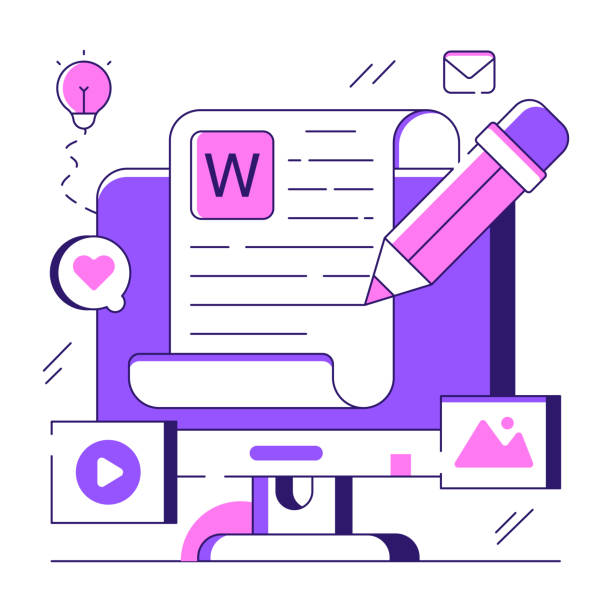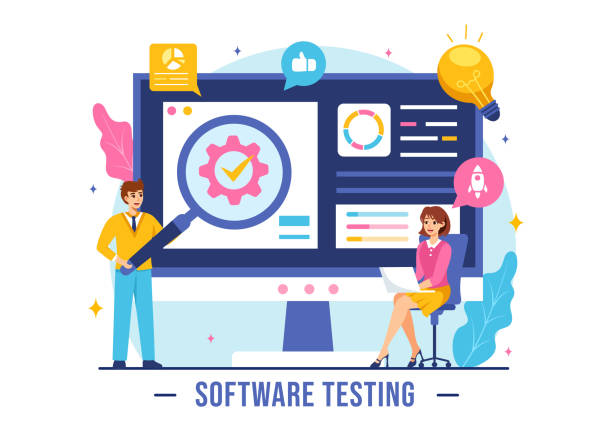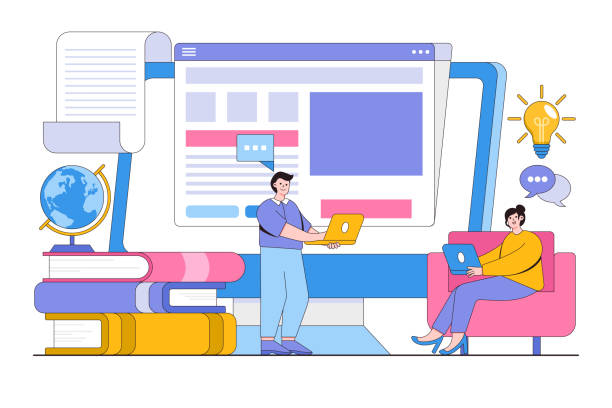Introduction to Fast Website Design: Its Importance and Necessity

In today’s digital world, #Website_Speed is one of the most important factors for the success of any online business.
Internet users have high expectations for page load speed, and even a few seconds of delay can mean losing visitors.
Fast website design is no longer a competitive advantage; it’s an undeniable necessity.
Slow websites not only offer a poor user experience but also see their rankings decline in search engines.
This directly impacts website traffic and, ultimately, sales or other website goals.
For this reason, understanding and implementing the principles of optimization for speed is crucial for every developer and website owner.
This guide will help you become familiar with various aspects of fast website design and build a website that is not only beautiful and efficient but also loads in the blink of an eye.
From the most basic concepts to advanced techniques, we will cover all dimensions of website speed so you can maximize your site’s performance.
The goal of this article is to enhance your knowledge in the field of fast website design and provide practical solutions for increasing page load speed.
We will further delve into the factors affecting speed and ways to optimize them.
Did you know that 85% of customers check your company’s website before any interaction?
With RasaWeb, build a corporate website that is worthy of your credibility.
✅ Increase credibility and customer trust
✅ Attract high-quality leads
⚡ Get free website design consultation
Why is Website Speed So Important for Users and SEO?

Have you ever wondered why websites need to be fast? Is it just user satisfaction, or do other factors play a role? #Page_Load_Speed is not just about user convenience; it’s a critical factor for ranking in search engines like Google.
Google has repeatedly emphasized that site speed is an important signal for page ranking.
This means that if your site is slow, regardless of content quality, it might rank lower in search results than faster competitors.
Furthermore, studies have shown that every second of delay in page loading can lead to a significant drop in conversion rates.
Today’s users are impatient; if your website doesn’t load within a few seconds, they will simply leave it and go to a competitor.
This not only means losing potential customers but also increases the Bounce Rate, which is another negative signal for search engines.
Consequently, to achieve online business goals, optimizing site speed is of utmost importance.
Fast website design not only improves user experience (UX) but also directly impacts SEO and conversion rates.
Fast websites keep users satisfied, retain them longer on the site, and increase the likelihood of desired actions (such as purchasing or signing up).
Therefore, investing in fast website design is a smart and strategic decision for any business seeking sustained success in the online space.
Key Factors Affecting Website Speed and Practical Solutions

To achieve #Fast_Website_Design, understanding the factors affecting it is essential.
These factors include image size and optimization, JavaScript and CSS code, the use of heavy plugins and themes, hosting and server quality, and caching and data compression.
Each of these can severely impact your site’s load speed on its own.
Image optimization is the first important step; large images can put a heavy load on the server and increase load time.
Using modern formats like WebP and proper image compression without significant quality loss is crucial.
Regarding code, compressing and Minifying CSS and JS files reduces their size, resulting in faster loading.
Additionally, asynchronous (Async/Defer) loading of scripts can prevent render-blocking.
Choosing quality hosting with high-speed servers is also highly important, as even if your site is well-optimized, inadequate hosting can slow its performance.
Using a Content Delivery Network (CDN) can also significantly increase loading speed for users worldwide, as content is delivered from the server closest to the user.
All these solutions together greatly contribute to a fast website design.
Below, the table examines some of the most important factors and their solutions.
| Factor | Impact on Speed | Optimization Solution |
|---|---|---|
| Image Size | Increased Load Time | Compression, converting to WebP format, Lazy Load |
| CSS and JS Codes | Render-blocking, increased requests | Minification, compression, file merging, asynchronous loading |
| Server and Browser Cache | Reloading duplicate information | Enable caching, set appropriate Headers |
| Hosting Quality | Slow server response | Choosing quality hosting with sufficient resources |
Essential Tools for Evaluating and Optimizing Website Speed

After understanding the factors affecting speed, the next step is to use appropriate tools for evaluating and #website_speed_optimization.
These tools help you identify your website’s weaknesses and find specific solutions to improve its performance.
One of the most famous of these tools is Google PageSpeed Insights, which provides a score between 0 and 100 for your site’s speed on mobile and desktop devices and offers suggestions for performance improvement.
Another widely used tool is GTmetrix, which, in addition to a speed score, displays detailed information about the load time of each page component and provides optimization suggestions.
Furthermore, Lighthouse, which is part of Chrome’s developer tools, performs a comprehensive audit of your website’s performance, accessibility, best practices, and SEO.
WebPageTest is also a more advanced tool that allows you to test your site’s load speed from different geographical locations and with various browsers.
These tools provide valuable information to help you make informed decisions for fast website design.
Regular use of these tools and monitoring changes after each optimization is an inseparable part of the fast website design process.
Understanding the output of these tools and taking appropriate actions based on their suggestions will help you achieve an optimized and fast website.
Does your current website convert visitors into customers or drive them away? Solve this problem forever with professional corporate website design by RasaWeb!
✅ Build credibility and powerful branding
✅ Attract target customers and increase sales
⚡ Get a free consultation now!
Optimizing Images and Media for Faster Loading

One of the biggest causes of slow website speed is #Unoptimized_Images and #Large_Media.
Many websites upload images directly without considering their size, which can severely impact page load time.
For fast website design, image optimization is a crucial step.
The first step is resizing images to appropriate dimensions for web display; there’s no need to load a 4000-pixel image in a space that’s only 800 pixels wide.
Then, compressing images without significant quality loss is important.
Many online and offline tools are available for this purpose.
Using modern image formats like WebP, which offer better compression than JPEG and PNG, can significantly reduce file sizes.
Additionally, implementing Lazy Loading for images and videos is very effective.
With Lazy Loading, media content only loads when the user scrolls to that part of the page, not from the very beginning.
This method, especially on pages with lots of content and multiple images, drastically reduces initial page load and contributes to a smoother user experience.
Media optimization is not limited to images; video files also need to be optimized.
Using compressed formats, pre-upload compression, and external video hosting services (like YouTube or Vimeo) instead of direct hosting on your server can help better manage resources and move towards fast website design.
These seemingly simple actions will have a profound impact on overall site speed and user satisfaction.
The Importance of Code Optimization and Cache Activation for More Speed

Code optimization and cache management are fundamental pillars of #High_Speed_Website_Design.
Heavy and disorganized CSS and JavaScript codes can cause render-blocking, meaning the browser must wait for all these codes to load and execute before displaying content.
To solve this, Minifying CSS and JS files (removing spaces, comments, and extra characters) and Gzip compression can significantly reduce their size.
Furthermore, asynchronous (Async) or deferred (Defer) loading of JavaScript files can allow the browser to render HTML while scripts load in the background.
Placing CSS in the `<head>` section and JavaScript at the end of the `<body>` is also a standard method to improve initial load speed.
On the other hand, cache management is a powerful tool for increasing load speed for returning visitors.
When a user visits your site for the first time, the browser can store resources such as images, CSS, and JS files in its cache.
This means that on subsequent visits, there is no need to re-download these files from the server, and the page loads significantly faster.
Enabling server-side caching also helps reduce database load and increase response speed.
Using caching plugins in Content Management Systems like WordPress greatly simplifies the process of activating and managing cache.
Fast website design is virtually impossible without paying attention to code optimization and proper use of caching mechanisms.
These actions not only improve user experience but also optimize server resources and reduce costs.
The Role of Hosting and CDN in Fast Website Design

Hosting quality and the use of a Content Delivery Network (CDN) are two very important and influential factors for #Website_Speed.
Even if you have performed the best optimizations on your site’s code and images, poor hosting or a server with insufficient resources can render all your efforts ineffective.
Choosing a reliable and high-quality hosting service that provides high-speed and optimized servers for your website is the first crucial step in fast website design.
Cheap shared hosts might seem tempting at first, but they usually have limited resources and severely slow down website performance, especially during traffic spikes.
Investing in VPS hosting or Dedicated Servers can significantly increase server response speed.
Alongside hosting, a CDN (Content Delivery Network) is an excellent solution for delivering content to users from the closest geographical point.
By distributing copies of your website content (such as images, CSS, JS) across multiple servers worldwide, a CDN ensures that when a user from a specific region requests your website, the content is delivered from the closest CDN server to them, not from your main server.
This significantly reduces latency (network delay) and greatly aids in load speed.
Using a CDN is especially recommended for websites with global audiences or high traffic and is considered an inseparable part of the fast website design strategy.
Below, the table compares different types of hosting and the role of CDN.
| Service Type | Features | Impact on Speed |
|---|---|---|
| Shared Hosting | Cheap, shared resources, suitable for small sites | May be slow, affected by other sites’ traffic |
| VPS Hosting | Dedicated resources, more control, scalability | Significant improvement in speed and stability |
| Dedicated Server | All resources belong to you, highest performance | Best speed and security |
| CDN (Content Delivery Network) | Caching content at various global points | Reduced latency, increased global load speed |
The Importance of Responsive Design and Speed on Mobile Devices

In the current era, where a vast portion of internet traffic occurs via mobile devices, #Responsive_Design and #Mobile_Speed are crucial for any website.
Google also places significant importance on Mobile-first Indexing, meaning it considers your site’s mobile version as the primary one for ranking evaluation.
Therefore, fast website design for mobile not only improves user experience but also directly impacts your site’s SEO and visibility in search results.
A slow mobile site can quickly lead to user loss, as mobile users are typically on the go and looking for quick and accessible information.
Responsive Design means that your website should automatically adapt to the user’s device screen size (mobile, tablet, desktop) and provide a seamless user experience.
This adaptability is not limited to appearance but must also include performance optimization.
For example, images should be loaded according to screen size, and unnecessary mobile scripts should be removed or deferred.
Using technologies like AMP (Accelerated Mobile Pages) can significantly increase page load speed on mobile, although it might introduce design and functionality limitations.
Given the growing trend of mobile internet access, investing in fast website design and responsive design for mobile devices is no longer an option but a strategic necessity to maintain competitiveness in the online market.
Recent news in the web domain also consistently emphasizes the importance of mobile speed and Core Web Vitals.
Tired of your e-commerce website not generating as much revenue as its potential? RasaWeb, specialized in professional e-commerce website design, solves this problem forever!
✅ Increase sales rate and revenue
✅ High load speed and unparalleled user experience
⚡ Get a free e-commerce website design consultation!
Continuous Monitoring and Maintenance to Preserve Website Speed

After completing all optimization steps and achieving #Fast_Website_Design, your work is not over.
Website speed is a dynamic issue and requires continuous monitoring and maintenance.
Various factors can affect your site’s speed over time, including adding new content, installing more plugins, updating the theme, or changes in site traffic.
Therefore, it is very important to regularly check your website’s speed using the tools previously introduced.
Setting up alerts in tools like Google Search Console or third-party performance monitoring tools can help you be immediately notified of any speed drops.
Furthermore, regular updates to the Content Management System (CMS), theme, and plugins not only enhance site security but can also bring performance improvements.
Removing unnecessary plugins and codes, periodic database optimization, and reviewing server logs to identify potential errors are also among maintenance actions.
Regular backups are also crucial to prevent data loss in case of an issue.
This continuous maintenance and optimization process ensures that your site always remains in its best functional state and provides an optimal user experience.
Fast website design is not a one-time process but a long-term commitment to improvement and stability.
With this approach, you can ensure the long-term stability and excellent performance of your website.
The Future of Fast Website Design and Emerging Trends

The future of #Fast_Website_Design is tied to continuous advancements in technology and user expectations.
Emerging trends in this field indicate that speed will become even more important in the future.
Technologies like PWA (Progressive Web Apps), which offer an app-like user experience in the browser and can work offline, will gain significant importance.
PWAs, using Service Workers and advanced caching, provide fast initial loading and instant content access.
Furthermore, continuous improvements in web standards and communication protocols like HTTP/3, based on the QUIC protocol, will significantly help reduce latency and increase data transfer speeds.
The role of Artificial Intelligence and Machine Learning in speed optimization is also growing.
These technologies can automatically compress images, optimize codes, or even predict which page the next user will visit and pre-load it.
Engaging discussions about the future of the web consistently focus on speed and efficiency.
How we can provide an immersive and instant experience for users anywhere in the world is a topic that occupies developers’ minds.
Fast website design is not just a technical requirement but a philosophy for delivering the best possible user experience.
By focusing on these emerging trends, we can ensure that our websites not only meet today’s needs but are also ready for future challenges, thus making the future of fast website design look very exciting.
Frequently Asked Questions
| Question | Answer |
|---|---|
| What is fast website design? | A process for building a website that loads quickly and provides a smooth and optimized user experience. |
| Why is site speed important? | Increased user satisfaction, improved search engine ranking (SEO), reduced bounce rate, and increased conversion rate. |
| What factors affect site speed? | Page size, number of HTTP requests, image optimization, JavaScript and CSS codes, server speed, and caching. |
| How can site speed be measured? | Using tools like Google PageSpeed Insights, GTmetrix, Pingdom Tools. |
| How can site speed be increased? | Image optimization, file compression (CSS, JS, HTML), browser caching, reducing redirects, choosing appropriate hosting. |
| Does fast website design mean low quality? | No, fast design means designing with a focus on speed and efficiency optimization, not reducing design or content quality. |
| What is the role of hosting in site speed? | The speed and quality of the hosting server directly impact the site’s response time and thus the load speed. |
| How can images be optimized for speed? | Using appropriate formats (like WebP), compressing images without significant quality loss, specifying definite dimensions for images. |
| Can complex websites also be fast? | Yes, by using appropriate architecture, code optimization, and resource management, even complex websites can have high speed. |
| Is fast website design the same as Agile development? | No, fast website design focuses on the end result (a fast website), whereas Agile development is a methodology for project management and software development. |
And other services of RasaWeb Advertising Agency in the field of advertising
Smart Advertising Campaign: Designed for businesses seeking campaign management through attractive UI design.
Smart Direct Marketing: A professional solution for improving SEO ranking with a focus on attractive UI design.
Smart Customer Journey Map: Designed for businesses looking to increase click-through rates through Google Ads management.
Smart SEO: An effective tool for digital branding with the help of attractive UI design.
Smart Advertorial: A dedicated service for online growth based on attractive UI design.
And over hundreds of other services in the field of online advertising, advertising consulting, and organizational solutions
Internet Advertising | Advertising Strategy | Advertorials
Resources
- Optimizing Website Speed for Improved User Experience
- UI and UX Design Principles in Website Design
- 11 Practical Solutions to Speed Up WordPress Website
- How to Increase Website Speed? A Comprehensive Guide
? Are you ready to transform your business in the digital world? RasaWeb Afarin Digital Marketing Agency smooths your path to online success by providing comprehensive services including professional website design, SEO, and social media management. Build your business’s future with us.
📍 Tehran, Mirdamad Street, next to Bank Markazi, Southern Kazeroon Alley, Ramin Alley, No. 6



